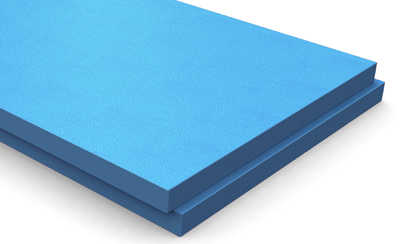General information
In the case of DUO or Plus roofs, thermal insulation is installed both under and above the waterproofing membrane of the flat roof. The thermal insulation above the waterproofing membrane may only be made with closed-cell polystyrene foam like RAVATHERM™ XPS.
This solution is especially relevant for flat roof refurbishments where waterproofing is in appropriate condition, but the thermal insulation of the roof made earlier with a straight order of layers no longer complies with the energy requirements.
It is also important that the thermal insulation layer above the waterproofing membrane provides not only thermal insulation but also protects the valuable waterproofing layer, so extending the working life and normal operation of the flat roof.
Other information
DUO ROOF
The double thermal insulation may be considered as a combination of roofs with straight and inverted order of layers.
The solutions called “duo” or “plus” roof can be applied in several cases:
- if the thermal inertia of structural layers under the rainwater proofing is little: their specific weight cannot exceed 250 kg/m2, and their total heat resistance is not higher than 0.15 m2K/W, and, therefore, there is a danger that their internal surface temperature sometimes (e.g. when the snow melts slowly) goes below the dew-point temperature (in such cases it is recommended to place at least 3 cm of thermal insulation under the waterproofing layer)
- in case of roof refurbishments, when the thermal insulation in the roof slab is not enough but the condition of the existing roof insulation does not justify its demolishment,
- when a new flat roof is built, or in the case of refurbishment, when the slope is created from the thermal insulation (e.g. EPS).
PLUS ROOF
With the energy requirement becoming progressively and continuously becoming stricter and stricter, flat roof may need to be refurbished even if their waterproofing layer is in good condition.
When flat roofs are refurbished, the possibility to keep existing layers is a fundamental issue. Using the principle of inverted order of layers, additional thermal insulation may be built in over the existing layers without demolishing them, by installing what is called a plus roof. In this way, not only the existing structure will be utilised, but considerable waste disposal costs may be avoided.
By the subsequent installation of RAVATHERM XPS thermal insulation boards above the existing rainwater proofing, the thermal protection of the existing roof structure can be significantly improved with a relatively small expenditure.
LIGHTENED PLUS ROOF
In cases where the load-bearing capacity of the roof does not allow for the installation of an at least 5-cm thick ballast gravel layer, the ROOFMATE LG thermal insulation board equipped with a 1-cm concrete crust designed for this purpose can be used as an alternative solution. With its 25 kg/m2 weight and tongue-and-groove edge design along the longitudinal sides, after installation of additional ballasting concrete tiles along the accentuated zones, it will comply with the wind-suction requirements in itself. It may be used if the waterproofing layer is glued on the entire surface.
Technical
INSTALLATION OF THERMAL INSULATION IN DUO ROOFS
The thermal insulation boards are to be laid on the roof loosely, in an offset bond. The boards can be cut to size using a hot wire cutter or thick-toothed saw on site.
The filtering, separating and surface-stabilizing layer, that is, the geotextile or water-guide film should be a non-absorbent material to avoid the possible creation of a water film over the thermal insulation boards.
The thickness of the ballast layer should be dimensioned for wind suction, but it should be a 50-mm thick washed 16/32 gravel layer. Adjacent to attic walls and roof superstructures, concrete tiles may be used as additional load based on the calculation.
WHEN REFURBISHING A ROOF
When the new, energetically dimensioned XPS boards are laid over an already existing thermal insulation and a waterproofing layer in appropriate condition on top of the thermal insulation, the ideal solution is a double thermal insulation made with XPS thermal insulation boards with a ballast as needed or, in case of a utilised roof, with a cladding or vegetation.
The usability, of course, needs to be preceded by statical checking in order to decide what function can be realized above the loadable new XPS layer.
The XPS thermal insulation hard boards, used in straight order of layers before, are to be laid on the roof – in appropriately sized thickness – on the roof. Ballasting needs to be ensured!
VAPOUR PROTECTION
If the condition of the vapour barrier layer in the existing roof is questionable, the thickness of the bottom and top thermal insulation layers is to be selected so that no vapour condensation occurs within the structure. If this condition is met, the structure will have all advantages of inverted roofs, and there is still no need for the installation of a separate vapour barrier layer.
If a green roof is to be installed on top of the new thermal insulation layer, the protection of the waterproofing membrane against roots needs to be checked and, if needed, ensured by installing another waterproofing layer.

